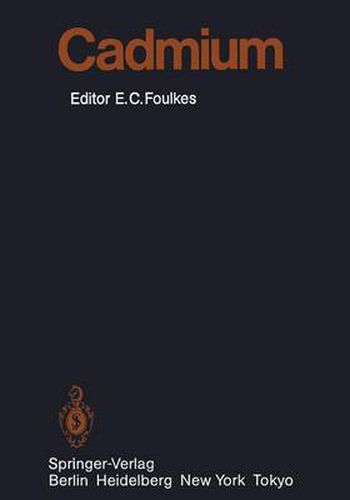Readings Newsletter
Become a Readings Member to make your shopping experience even easier.
Sign in or sign up for free!
You’re not far away from qualifying for FREE standard shipping within Australia
You’ve qualified for FREE standard shipping within Australia
The cart is loading…






This title is printed to order. This book may have been self-published. If so, we cannot guarantee the quality of the content. In the main most books will have gone through the editing process however some may not. We therefore suggest that you be aware of this before ordering this book. If in doubt check either the author or publisher’s details as we are unable to accept any returns unless they are faulty. Please contact us if you have any questions.
The toxic properties of cadmium compounds have been well recognized in many species. There is little evidence to suggest a physiologic role for the metal. Rather, because of its long biologic half-life, cadmium acts as a cumulative poison, and even at quite low ambient concentrations, it can accumulate in mammals to values not insignificant in terms of critical toxic levels. The problem of cadmium toxicity has become especially important, as cadmium concentrations in the environment have begun to rise owing to a variety of human activities such as mining, the metallurgical industry, coal combustion, and the use of cadmium-containing fertilizers. It seemed appropriate, therefore, to assemble in one volume an up-to-date analysis of the mechanism of action of cadmium on biologic systems. Aspects of this field have repeatedly been reviewed in the past, and particular reference must be made to the volumes prepared by FRIBERG and collaborators from Sweden. Much outstanding work on cadmium has also been reported from Japan, and I am happy that investigators from both countries were able to contribute to the present volume. Obviously, this volume does not report a consensus by its contributors. The purpose of the work was to permit leading investigators in the field to present a critical review with sufficient documentation to support their interpretations and conclusions. A certain amount of overlap and disagreement between chapters was therefore unavoidable. The result, I hope, will be a useful state-of-the-art discussion.
$9.00 standard shipping within Australia
FREE standard shipping within Australia for orders over $100.00
Express & International shipping calculated at checkout
This title is printed to order. This book may have been self-published. If so, we cannot guarantee the quality of the content. In the main most books will have gone through the editing process however some may not. We therefore suggest that you be aware of this before ordering this book. If in doubt check either the author or publisher’s details as we are unable to accept any returns unless they are faulty. Please contact us if you have any questions.
The toxic properties of cadmium compounds have been well recognized in many species. There is little evidence to suggest a physiologic role for the metal. Rather, because of its long biologic half-life, cadmium acts as a cumulative poison, and even at quite low ambient concentrations, it can accumulate in mammals to values not insignificant in terms of critical toxic levels. The problem of cadmium toxicity has become especially important, as cadmium concentrations in the environment have begun to rise owing to a variety of human activities such as mining, the metallurgical industry, coal combustion, and the use of cadmium-containing fertilizers. It seemed appropriate, therefore, to assemble in one volume an up-to-date analysis of the mechanism of action of cadmium on biologic systems. Aspects of this field have repeatedly been reviewed in the past, and particular reference must be made to the volumes prepared by FRIBERG and collaborators from Sweden. Much outstanding work on cadmium has also been reported from Japan, and I am happy that investigators from both countries were able to contribute to the present volume. Obviously, this volume does not report a consensus by its contributors. The purpose of the work was to permit leading investigators in the field to present a critical review with sufficient documentation to support their interpretations and conclusions. A certain amount of overlap and disagreement between chapters was therefore unavoidable. The result, I hope, will be a useful state-of-the-art discussion.